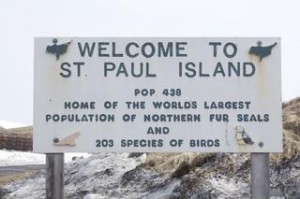
After more than a hundred years in the Smithsonian Museum collection, the remains of two people from St. Paul Island have been returned to the community.
In 1868, just a year after the purchase of Alaska, the Revenue Cutter Wyanda visited the Aleutian and Pribilof Islands. The trip was a reconnaissance mission to find out what kinds of riches the territories held.
“So, there was a doctor on board, Dr. Thomas Minor and I believe that the Smithsonian did interact with him prior to this trip, you know, ‘if you find anything of significance then bring it back,'” says Aquilina Lestenkof, the cultural program coordinator for St. Paul’s tribal government.
Among the things Minor brought back were two skulls, a man and a woman. A handwritten tag accompanying them indicated they were from St. Paul Island, which Lestenkof had a hard time believing at first.
“I never, ever thought anyone would take human remains from the Pribilof Islands.”
That’s because the Pribilofs weren’t settled until the late 1700s and by that point in time most Unangan people had converted to Russian Orthodoxy.
“And so by then people were buried in the cemeteries, so…”
Lestenkof didn’t think someone would have dug the skulls up from the village cemetery, so she started looking at old maps of the island for other possible burial sites. She found reports that an abandoned village site called Polivina had had a cemetery, so Lestenkof set off to find it.
“I just was walking large pieces of land and [thinking] ‘gosh if I can just see a bone sticking out.’ And then you think ‘it seems really weird to wish you could see a human bone sticking out of the ground,’ but [I wanted to find] something to give me some sign.”
Lestenkof says she was thinking that maybe, just maybe, if she could find the cemetery, she could reunite the skulls with the bodies of the two people. But she didn’t find anything.
“I don’t know that we’ll ever solve that mystery.”
Lestenkof says it’s frustrating that these people may never be reunited with their bodies, but she’s not angry with Dr. Minor and those who may have helped him.
“I don’t spend my time feeling anything about those people. I think at this point it’s how are we going to feel about being the ones who put them back to rest. I think that’s where we need to focus our efforts.”
So, Lestenkof is turning her attention to the upcoming tribal council meeting, where community members will have a chance to give their input on where the remains should be buried. She thinks the skulls will probably be given a Russian Orthodox burial, in keeping with the dominant religious tradition in St. Paul, but she’s leaving the options open.
“If you’re talking bits and pieces over the year, it’s definitely very different when you have them here in front of you and you have to make that decision.”
No matter what the community decides, Lestenkof says it will be better than sitting on a dusty shelf in the Smithsonian.
“It’s a story that definitely shows where we at a hundred plus years ago and where we are now.”
The St. Paul repatriation is just the beginning. The Smithsonian is planning to return dozens of human remains to communities across the Aleutians over the next few years.




